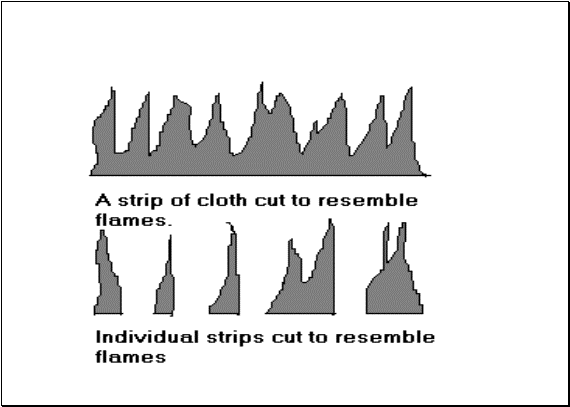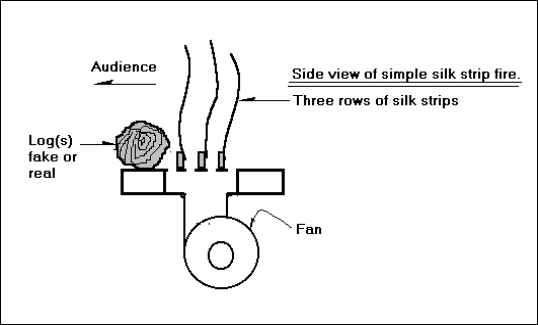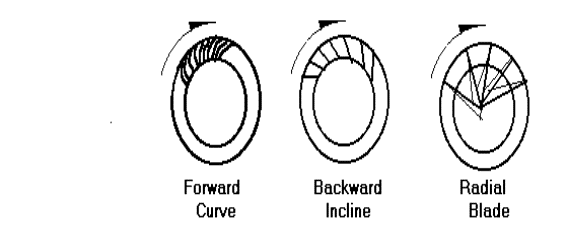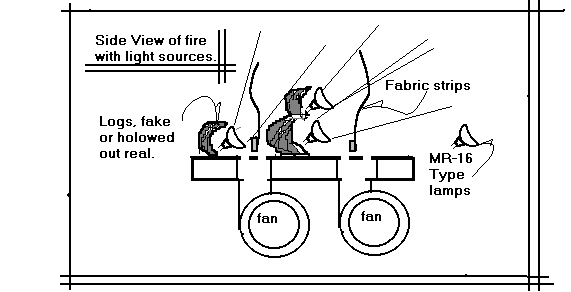Hello and welcome to the TECHIE’S CORNER. When last I wrote we were discussing fire. This month’s column will touch on”Fire the Old Fashioned Way”. Fire has been a major problem in civilized urban areas as long as man has been civilized and urban. It has only been in the last century that man has found a source of light, other than flame, for lighting his world. Flame in the form of candles, torches, oil lamps, gaslight, limelight etc. When theatre began to emerge from the dark ages in the form of pageants, passion plays and miracle plays, gone were the stone and marble edifices of the Greeks and Romans. The permanence of great stone structures was reserved for cathedrals, castles, forts and palaces. Structures and buildings for spectacles, pageants and theatre were now built mostly of wood and of course, wood burns. In addition as theatre emerged in it’s own right the trappings of the stage were largely made of wood and canvas, costumes were large and voluminous, all combustible. Since that time, one of the most common forms of death and destruction in the theatre has been the result of fires.
Theatre has always thrived on some form of spectacle. Special effects have been with us since the time of the Greeks. Buildings on fire, volcanoes erupting and explosions are all exciting events on stage. But how do you do it safely and night after night? This month we will look at one of the oldest and simplest forms of fake fire, the silk streamer and blower method.
The most recent time I have seen this method use was in the ice capades where a small wall of flames rose suddenly behind the skaters for a few moments and then disappeared with no trace of smoke or heat. The lack of smoke can be an advantage or disadvantage depending on the final desired effect; in this case it was a definite advantage. In an ice show the ability to produce flames without heat is an obvious advantage. Of course the silk streamer method does not need the approval of the fire martial which is always a plus.
Simply stated, the “flames” are strips of some very light weight but tightly woven cloth, cut into strips or a series of strips to resemble flame shapes. The thing that makes the flames look the most realistic is the color or “dye job”. A good color job on fabric flames is a variegated blend of color from the base to the tip and from flame to flame. Real flames tend to be a deeper red-orange color at the base and more light orange or yellow toward the tip. Occasional flecks of blue and green can add additional reality to the look of a flame.
Until the middle of the 20thcentury, silk was the fabric of choice as it was very light weight, tightly woven and would easily take bright colors of dye. Silk also had a shimmer or sheen that would reflect light very effectively. Now there are a number of synthetic fabrics that can be used. Rayon, nylon and polyesters galore are available. How long should the strips be? How many should there be? The length of the strips is determined by the desired look and the strength of the fan or blower you have available. The most common length I have seen or used is between 10” and 24”.Less than 10” is hardly effective and with strips longer than two feet it is very difficult to prevent tangling. The number of strips is again, determined by the desired look. Generally two or three look the most realistic, but even a single row can look great when lit well.
Silk strips are nothing without some form of air movement to raise and flutter the streamers. Some of the methods used by our forbearers are at once, primitive, ingenious and incredible. One method used by early church pageants and miracle plays was the “Bellows” method. In this method, a large bag of leather was fitted with a number of bellows or manual “air pumps” with one way valves. The “air pumps” were operated by many means such as hand pumps similar to today’s fireplace bellows, or by foot pumps like those found in old pump organs, or giant fireplace bellows operated by a water wheel. By this means air could be pumped into the bag from the bellows, but could only escape by blowing past the silk streamers. The leather bag was then compressed by weights or simply by a person sitting on it! Much like a bagpipe, it then produced a steady flow of air rather than a series of “puffs”. Today a chamber such as the leather bag is known as a plenum chamber.
Today the airflow is provided almost exclusively by electric fans or blowers. Fans with a propeller type blade are a poor choice for this effect as they produce an air current that looks like the double helix of a DNA molecule. This has a pronounced tendency to twist and tangle the streamers. Fans or blowers known as squirrel cage fans are a far better choice. First the airflow is in a straight linear column. Second the squirrel cage type of fan produces a greater “force” known as static pressure. Static pressure produces greater “push” against the fabric streamers for the same or less air velocity and noise as propeller type fans. Squirrel cage fans are also known in the air moving industry as “centrifugal blowers”. There are three types of blowers named by the shape of the blades or fins that make up the fan. They are: the Forward Curve (FC), the Backward Incline (BI) and the Radial Blade (RB).


The forward curve is the most common and the one you are most likely to encounter. The FC blower is the quietest and produces the greatest airflow for the noise level. The BI and RB type blade blowers produce, respectively, increasingly greater air flow and noise levels.
So, for example, a quiet, romantic fireplace would probably need an FC type of blower. A large flame coming from a burning building window with crowd noise and sirens might ask for a BI type. Flames spouting from a distant volcano or a boiler explosion might need the extreme airflow of an RB blower.
For the most part, 90% of the blowers the average consumer is going to encounter is the forward curve type. For fireplace or a windowsill, a wide narrow blower is needed such as those offered by Grainger as Tran flow or low profile blowers. These blowers run from $45 to $95 and are listed in the 4C743 and 4C825 series. Other suppliers such as McMaster-Carr et al have many similar blowers.
The final thing that makes this fire effect work is the lighting. To be perfectly honest I cannot find, nor imagine a good, safe, way to light fabric flames without electric light sources. Today we have a number of very bright, sources of light such as the MR-16 type lamps. These are very small and can be concealed rather easily.
While I have shown MR-16 lamps in the sketch, any type of lamp that you can use will work to a greater or lesser degree. I should mention here that the lamps should always be aimed so that when the fans are off, the light is not aimed at the fabric. Otherwise the fabric without the air cooling effect can catch fire very rapidly.
The descriptions and illustrations of the fire effect may seem a bit vague so far. That is true. The reason is that this effect is very much a trial and error type of thing. The exact fabric you choose, the particular “look” of the fire, whether a campfire, or a fireplace etc, the space you have for lamps, the size and shape of the air holes, etc will all affect the exact operation of the effect. It is a rather easy and surprisingly realistic way to produce fire on stage but it does take a bit of work to get it the way you want.
As with all the tech tips I write about, if you want to give them a try and need some help, feel free to contact me.
Until next month, Don’t sweat the small stuff, and remember …. It’s all small stuff!
Michael Powers



